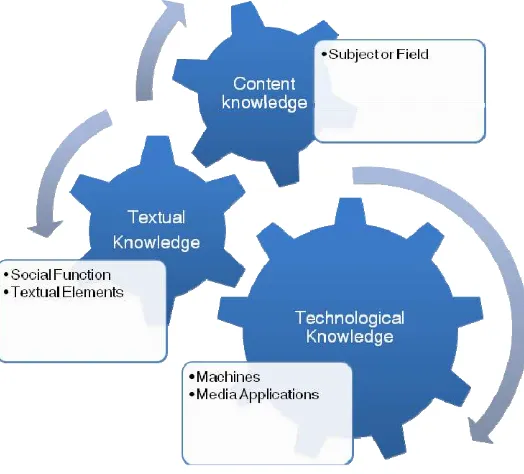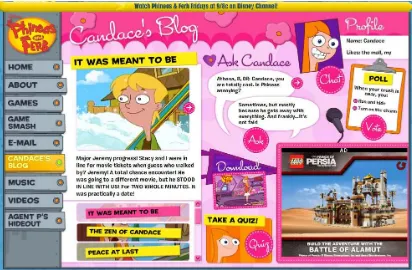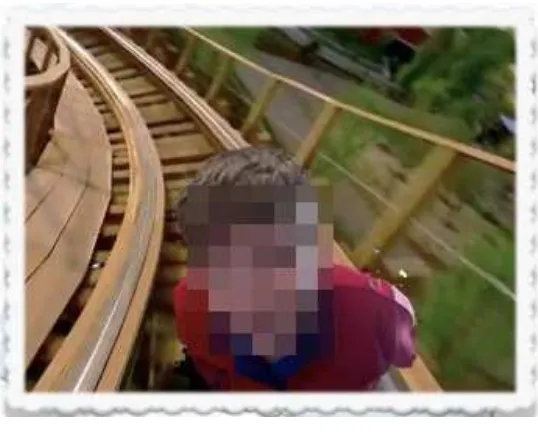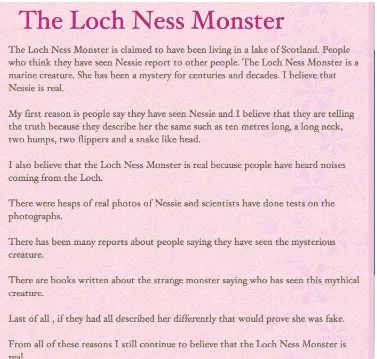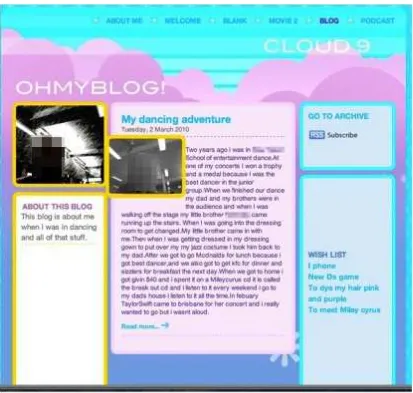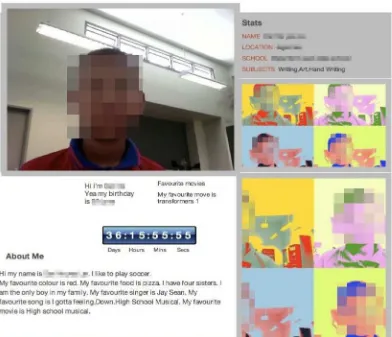Volume 7 Number 3 2010 www.wwwords.co.uk/ELEA
What Learners ‘Know’ through Digital
Media Production: learning by design
KATHY A. MILLS
Faculty of Education, Queensland University of Technology, Brisbane,
Australia
ABSTRACT The power to influence others in ever expanding social networks in the new knowledge economy is tied to capabilities with digital media production that require increased technological knowledge. This article draws on research in primary classrooms to examine the repertoires of cross-disciplinary knowledge that literacy learners need to produce innovative digital media via the ‘social web’. The article builds on Learning by Design and the ‘knowledge processes’ to describe ‘how’ learning occurs, while presenting a model to theorise ‘what’ students know – the ‘knowledge assets’ – when learners produce digital and multimodal texts.
This is my first movie. My name is Malachi [names are pseudonyms]. The thing I found easy about computers is really everything. The thing I found hard is nothing.
Malachi is an indigenous Australian eight-year-old who struggles with writing and attends school in a low socio-economic district. He produced a podcast containing this excerpt after participating in a series of digital media-based literacy lessons involving the production of blogs, web profiles, podcasts and movies. His statement highlights what practitioners have long known intuitively about the potentials of new digital media to engage disadvantaged learners in textual practices. It also suggests the need for a systematic way of theorising, grounded in a coherent epistemology, what students are really coming to know when they engage in textual practices using digital media.
Figure 1. The ‘knowledge processes’ of Learning by Design (adapted from Kalantzis & Cope, 2008).
Figure 2. ‘Knowledge assets’ for digital media design.
Technological Knowledge
students enjoy using new technologies for digital media production, but we cannot assume that all students have the necessary skills for participation in the knowledge economy simply because they play video games for pleasure. For example, eight-year-olds engaged in a digital media research project reported in their podcasts:
I like doing computer stuff, but it’s hard to type ... and I like my friends ... and they help me. (Jade)
My favourite part about computers is Photo Booth. What I have not liked about computers is getting stuck. I liked it when people helped me when I was stuck. (Emily)
Kalantzis & Cope et al (2005), drawing on Castells (2000, p. 16), Stewart (1998), and others, have argued that the knowledge economy is heavily dependent on technologies that assist the flow of information – ‘within enterprises, between enterprisers, and between enterprisers and consumers’ (Castells, 2000, p. 16). Technological knowledge is a means of productivity gains and competitive advantage. Those who lack the newest technological knowledge find themselves debilitated socially, economically, and culturally, as others find information faster, work smarter and more flexibly, and produce knowledge, media, and commodities that have global influence. Castells (2000, p. 17) argues: ‘Indeed, technology is now very much a relationship between tools and the knowledge of these tools in people’s heads’. Societal and technological changes require shifts in the epistemology of education: technological knowledge counts.
Textual Knowledge
When learners engage in the process of digital media design, they draw on textual knowledge, which includes both knowledge of the social and cultural context in which the text is produced and used, and the multimodal elements within the text. These include the visual, audio, spatial, gestural, and linguistic design elements that are combined in unique ways to synergistically represent meaning (Mills, 2009). Linguistic elements have been categorised in various ways, with linguists distinguishing between the phonological, lexical, grammatical, and generic structures of language that form the substantial content of English curricula.
Multimedia information and new communications technologies are tied to the hybridisation of textual knowledge. Digital technologies and the related convergence of the industries of computing, broadcasting, and publishing have contributed to shifts in choices of modes, genres, and linguistic structures. For example, instant messaging among English and Cantonese users draws on common grammatical ‘errors’ and shortenings, unconventional verb forms and lexical choices, and creative orthographic representations (Lee, 2007). These patterns of spontaneous hybridisation of grammar, vocabulary, and orthography are causing linguists and literacy educators to reconsider the shape of textual knowledge in a digital age (Mills, 2010b).
Content Knowledge
In the process of digital media production, learners also draw upon content knowledge of the text that is produced. Content knowledge refers to funds of facts, concepts, and theories in the designer’s head. Depending on the social purpose and audience of the multimedia text, this prior knowledge may draw upon sources such as personal experiences, experts, authorities, and other texts. To engage in digital media production involves knowing certain information about the subject represented, including the ability to use certain discourses and domain-specific vocabulary for different communities of online users.
The Rise of Digital Media Production: Web 2.0 – the ‘social web’
The World Wide Web is a significant feature of contemporary life, particularly for communication and social networking since the rise of the ‘social web’ or Web 2.0 (O’Reilly, 2005). When contrasted with the earlier applications of the World Wide Web, Web 2.0 has increased the ease and reduced the cost of online collaboration, such as polls, blogs, podcasts, microblogs, social networking sites, wikis, and other more democratic forms of user-generated content. Also referred to as the ‘read–write’ web, Web 2.0 provides a means for free, rapid dialogue and instant feedback from significant international audiences (Wheeler & Wheeler, 2009).
These online tools provide an infrastructure that supports collaborative digital media design among all ages, encouraging what media theorists describe as a ‘participatory culture’ of digital media production (Jenkins et al, 2009). In educational practice, these shifts in Web-based social practices call for a greater emphasis on the content of the knowledge that is drawn upon when learners produce digital media, and how this occurs.
Experiencing the Known and the New: digital media design
When learners engage in digital media production, they experience or perceivenew technological knowledge through personal and sensory engagement with digital tools, such as laptops and cameras, and a broadening array of software applications for specialist media production. This engagement with digital technologies of textual production involves the self, emotions, and immersion in the human and natural world. Like other experiences in the world, this should be conscious, systematic, explicit, and structured.
Kalantzis & Cope et al (2005) distinguish between two distinct ways of experiencing: experiencing the known, and immersion in new experiences. ‘Experiencing the known’ involves drawing on familiar lifeworld experiences, prior knowledge, community background, personal interests, and the cultural resources of learners. Examples include sharing about favourite video games, brainstorming what students already know about a topic, or using popular multimedia texts in the classroom.
For example, a media teacher-researcher introduced a lesson on blogging to several classes of Year 4 students in a public school situated in a low socio-economic area. The students were from a range of ethnic backgrounds, including indigenous Australian, migrants, and economically marginalised Anglo-Australians. Using her laptop connected to the Internet and a data projector, the media teacher displayed part of the Disney fan site to show an example of a blog for primary-school-age children (see Figure 3). There were some ‘Oohs’ and ‘Aahs’ as the Disney blog was displayed – it resonated with their previous experiences of popular multimedia texts. Students were highly engaged in this phase of the lesson. The multimodal dimensions of the text attracted their attention – the combination of visual, spatial, gestural, and linguistic elements – and text content about Candace having a secret ‘crush’ on Jeremy, the fictional male character in the blog, allowed them to experience the known. The teacher used a text with content that was part of their existing lifeworld experiences in order to make links with the ‘new’ – the knowledge of the conventions of a blog that was remote from many of the students’ prior experiences.
Experiencing the New
‘Experiencing the new’ is immersion in unfamiliar, real, or simulated experiences, communities, situations, and texts (Kalantzis & Cope et al, 2005). For example, the same media teacher introduced students to Apple Photo Booth software for capturing and applying special effects to still images. The students worked in pairs on laptops with built-in webcams. The teacher gave the classes brief instruction using a data-projected image of her computer screen, demonstrating how to open the Photo Booth application using the icon at the bottom of the desktop, position themselves in front of the built-in webcam, and capture their image using the timed countdown.
Figure 4. ‘Rollercoaster’ and ‘Fish’ special effects.
The students were later shown how to insert the iSight widget (embedded web application) into their iWeb podcast pages, and were able to transfer their knowledge of Photo Booth functions to a new application. Producing digital media sometimes involves introducing unfamiliar technological knowledge, which makes sense through a degree of immersion – experimenting and interacting with a new digital tool to discover its affordances.
Conceptualising by Naming and Theorising: digital media design
Conceptualising is the translation and synthesis of experiences, conceptual forms, language, and symbols into abstract terms and generalisations (Kolb, 1984; McCarthy, 1987). For instance, in the blogging lesson described above, the teacher discussed the meaning of the terms ‘blog’ and ‘blogging’. Students were required to ‘conceptualise by naming’ the purpose and features of a blog. The teacher compared blogs to journal and diary writing, because these texts recount experiences or share interests and opinions – ‘Remember, blogs are quite short and allow you to say what you think of things’ These text types share common features, such as ordering events in chronological sequence, using the first person and past tense, and cohesive ties, such as ‘today’, ‘then’, ‘next’, and ‘later’.
The students learned that words, groups of words, and visual and spatial elements can be included in blogs to portray ideas in different ways for certain audiences. By engaging with Candace’s blog (Figure 3), they came to know that blogs are frequently supported by other interactive media content, identifying additional features such as quizzes, games, pictures, polls, downloads, and chat facilities. Conceptualising by naming involves categorising and grouping particulars together based on their similarities, despite them also having differences (for psycholinguistic theory about naming concepts, see Vygotsky, 1978).
Conceptualising by Theorising
conventional and multimodal texts. She taught them the structure and textual features of expositions, with focused learning episodes on grammatical, vocabulary, and orthographic knowledge.
Margaret wanted to extend Lisa’s love of print to develop new capabilities with technologies for inscription. The class participated in eight weeks of specialist media lessons, which involved designing web profiles, blogs, short movies, and podcasts. At the end of the unit, Margaret gave the students the choice to either podcast their written exposition about a world mystery or present it as an additional web page of text. Margaret explained that she wanted the students to choose the mode – audio or written – in which they felt most able to communicate their message effectively.
Lisa chose to present her exposition as an additional page of text on her website, as Margaret had anticipated. Lisa’s exposition providing evidence to support the existence of the Loch Ness Monster is shown in Figure 5.
Figure 5. Lisa’s web page of text.
Analysing Functionally and Digitally: digital media design
You don’t have to agree with the author. That’s the beauty of books. (Teacher)
Most children and youth today have ready access to a host of consumer-driven media, print, and online texts from a much wider range of sources than previous generations. While experiencing and conceptualising are important, neither of these addresses the need for analytical knowledge. When used alone, these forms of knowledge socialise learners to be uncritical and unconscious of the cultural origins of knowledge and the world view that validates it. Similarly, it does not involve critically analysing the social practices surrounding the production and use of multimedia texts (Kalantzis & Cope, 2000).
Children who are old enough to be entertained by videos and television programs need the conceptual tools and knowledge to understand, select, challenge, and evaluate the messages of texts, and to recognise who benefits from the media they consume. ‘Analysing’ repositions students as active, critical agents, rather than as passive automatons. It involves examining the discreet structure and function of represented meanings (Kalantzis & Cope et al, 2005, p. 114). Firstly, users ‘analyse functionally’ the overarching function of the multimedia texts that they read or view, making connections between and across modes. Readers and viewers also make connections between the content of subject matter and the social contexts and purposes of texts (New London Group, 2000). For example, when confronted with Internet advertising, children can ask themselves questions about whose interests are served. They can begin to understand how certain words, images, music, gestures, and animations are chosen very deliberately to catch their attention and influence children to select one product over another.
More importantly, they analyse the explicit and implicit agendas and interests behind a text – ‘analysing critically’ – whether it be a video game, billboard graphic, or Internet fan site. For example, students might analyse the gendered use of colour, font styles, and images in websites aimed for boys and girls. In this section, I focus on the degree to which a primary teacher enabled students to engage in new ways of knowing by analysing popular media functionally and critically.
Analysing Functionally
In the context of a digital movie-making unit among upper-primary students, the teacher taught the students how to ‘analyse functionally’ the representations of power and other values embedded in commercially produced movies and books. The class comprised the lowest literacy ability group in the year level in an Australian school in a low socio-economic area. Diverse ethnicities were represented among the cohort, including indigenous, Sudanese, Thai, Maori, and Anglo-Australian students, and those from non-English-speaking backgrounds.
In the following transcript, the students had viewed several segments of the popular stop-motion animation Chicken Run by Aardman Animations, producers of the Wallace and Gromit films (Mills, 2010a).
Teacher: When the door opened and Mrs Tweedie was standing there, the light spilled out onto
the steps. Why did they use the lighting in that way? What effect did it give her that she was in shadow and the bright light coming behind her when it panned up her leg?
Jack: Strong.
Teacher: Yeah, it made her look powerful!
Ted: Scary.
Teacher: She did look a bit scary. OK, how did the creators show that Mrs Tweedie was in power?
How did they show that she was the boss, Nick?
Nick: The expression.
Teacher: The expression on her face. Did you hear the dog yelp? The door opened and the dog
went? [child barks] Yeah, and did a little yelp – which means that he was definitely scared. What did you think?
Daria: She had her hand on her hip.
Teacher: Her hands were on her hips. Her body language showed that she was really very
important.
Teacher: So, what she said was important.
Julia: You could see her face and her head.
Teacher: Think of the angle. Where was she? Where are they [the chickens]? What did the
creators do to make her look more powerful, Ted?
Ted: Looking up [camera angle].
Teacher: They were looking up at her, and she was looking?
Students: Down.
Teacher: Down. This made them look as if they were quite small.
The teacher used a series of strategic questions and responses to guide the learners to analyse functionally how power was represented through lighting (‘Why did they use the lighting in that way?’), facial expression (‘The expression on her face’), and bodily movements or gestures (‘Her body language showed that she was really very important’).
They also analysed functionally the sound (‘Did you hear the dog yelp?’), speech (‘So, what she said was important’), and spatial elements, such as camera angles, spatial relations between characters, and how the viewer is positioned (‘Think of the angle. Where was she? Where are they?’). These questions encouraged the students to analyse how the movie and its multimodal elements function to achieve the producers’ purposes (Mills, 2010a).
This analysis of the movie involved critical engagement and multiple readings that extended beyond linguistic design (written and spoken words). The students also attended to the spatial, visual, audio, and gestural elements that work harmoniously to create meanings of significance. Through this functional analysis of multimodal design elements and their dynamic connections, the deeper meanings of the movie were illuminated (Mills, 2010a).
Analysing Critically
A second kind of analysis is necessary when students read and are confronted by the messages in everyday digital media texts. ‘Analysing critically’ is a process of cross-examining human intentions and vested interests in a design. Questions can be asked about whose point of view is represented, and what the social and economic consequences could be (Kalantzis & Cope, 2008). For example, when analysing toy catalogues, students consider whose interests are served, identify the intended product consumers, and analyse how gender, ethnicity, and age are constructed in relation to marketing toys for subcultural groups. The learner considers the perspective represented by the design, and the social, economic, cultural, or political consequences that arise from its use (Kalantzis & Cope et al, 2005).
Another lesson excerpt serves to demonstrate how an upper-primary teacher guided her students to analyse critically – to interrogate the underlying intentions and interests of movie authors and producers. Prior to the following interactions, the teacher had also shown the students segments of Chicken Run. She had replayed certain scenes and addressed key questions, which were reviewed in the ensuing discussion (Mills, 2010a).
Teacher: What is the message that the movie creators are trying to get across to you? What does
he really want you to think about during this movie, Ted?
Ted: Not to stop trying.
Teacher: You’re not to stop trying. Don’t give up. Oh, excellent! What’s another message, do you
think?
Mia: They are prisoners.
Teacher: That the chickens are prisoners! What else, Ted?
Ted: That the chickens want to get free.
Teacher: To free the chickens. Do you think that’s why they made the movie – to try to make
you think about chickens that are in captivity?
Conner: Don’t lock chickens up.
meaning of the text: ‘That the chickens [in captivity] want to get free.’ In the absence of the teacher’s questioning, the learners would not have examined the underlying message about animal captivity, nor recognised the way they were positioned as viewers to empathise with their feathered friends in Chicken Run.
The learners gained access to designs of meaning by considering the message of the text (‘What is the message that the movie creators are trying to get across to you?’). They were guided to think about whose point of view or perspective was represented (‘That the chickens are prisoners’ which ‘want to get free’). They examined whose interests were served, and the social and environmental choices associated with poultry farming (e.g. The teacher asked, ‘Are there chicken farms where chickens are allowed to run free?’) (Mills, 2010a).
This example illustrates that analysing critically involves regarding media texts as being dependent on social practices and political, economic, historic, and ecological contexts. Learners need to engage in analysing critically to consider how designs of meaning are culturally specific, serving particular social and environmental ends. These learners were beginning to critically analyse the underlying human intentions and interests of the authors and producers, which drive the consumption of multimodal texts in children’s everyday world of textual experiences, from book to screen. They were encouraged to consider multiple readings of texts and alternate points of view rather than unlocking or reproducing the ‘correct meaning’. These powerful knowledge processes are necessary for learners to contest the pervasive consumer culture characteristic of the new times (Mills, 2010a).
Applying Appropriately and Creatively: digital media design
Barbara is a confident student academically, and producing digital media for the first time was no exception. When given the opportunity to create her first web profile using the iWeb application, she was able to apply the demonstrations by the media teacher to her design. For example, the teacher used a laptop and data projector to demonstrate how to open the iWeb application, choose and modify a template, and how to save and publish the design (see Figure 6).
Barbara’s blog page demonstrates that she was able to produce a substantial quantity of written text, applying her knowledge of the technologies, textual conventions, and her experiences of the world appropriately. ‘Applying appropriately’ involves acting upon knowledge learned in a typical way. For example, Barbara’s blog shows appropriate attention to linguistic, visual, and spatial elements of the screen, including a substantial quantity of written text in each entry. She modified the iWeb template by inserting her own images with special effects, which were matched to the content of the blog. She included supporting text features, such as a title, summary, and ‘wish list’.
Figure 6. Barbara’s blog – web page.
Applying Creatively
Yet Barbara’s blog demonstrated more than a simple reproduction of technological, textual, and content knowledge. Exact replications do not constitute applying appropriately because there is always a degree of transformation – an element which is different to what has gone before (Kalantzis & Cope et al, 2005). Applying creatively takes knowledge from one setting, adapting it to a new setting in a radically different way. For example, Barbara’s blog was different to the blogs produced by her peers. While her blog contained some elements of the original iWeb template, such as the background colour, graphics, and spatial layout, it was characterised by a unique combination of multimodal elements – words, images, font styles, gestures, and special effects – that told her story. Transferring creatively entails removing knowledge from one context to work in a new context in a different way, resulting in generative hybridity, divergence, and originality (Kalantzis & Cope et al, 2005).
level peers. The teacher corrected the linguistic elements of his iWeb profile while in a handwritten form, prior to Jao creating his digital text.
Figure 7. Jao’s ‘About Me’ iWeb page.
Jao’s web profile shows evidence of ‘applying creatively’ and hybridisation – the mixing of different conventions in a text, which is realised in the heterogeneity and creativity of the design (Fairclough, 2000). Hybridisation is important because it draws attention to change, rather than stasis, in the digital media designs. For example, Jao’s ‘About Me’ page included a greater emphasis on images than written text, including self-portrait photography that combined conventional and ‘pop art’ stylistic effects. Jao included a hybrid combination of web-page features, such as a welcome comment, biographical note, favourites list, birthday countdown, and personal statistics. Digital media production requires that students can create textual designs which are characterised by hybridisation, using original combinations of existing technological, textual, and content knowledge.
Similarly, in the process of applying knowledge creatively in digital media design, learners frequently make intertextual connections between the meanings represented in various texts (Cope & Kalantzis, 2000). Intertextuality refers to the cross-referencing of recognisable connections and juxtaposed meanings between texts (New London Group, 2000). For example, Jao’s blog contained cross-references to popular songs and movies. Hybrid intertextuality involves transformations of original resources for meaning making (Fairclough, 2000).
Conclusion
globalised networks. This article has provided evidence for an active and dynamic process of ‘coming to know’ when students create digital and multimodal texts. Learners were guided through a process of experiencing, conceptualising, analysing, and applying new combinations of technological, textual, and content knowledge – ‘knowledge assets’ for digital media design. Creators of digital media in a Web 2.0 network do more than simply reproduce a narrow canon of fixed disciplinary content and print-based conventions. Rather, learners engage in the transformation of existing multimedia designs, creating globally oriented funds of knowledge that are easily expanded and adapted to meet changing criteria for success in the new times.
Acknowledgements
My colleagues on the project include Annette Woods, Allan Luke, Karen Dooley, Vinesh Chandra, John Davis, Michael Dezuanni, Beryl Exley, and Amanda Levido of Queensland University of Technology, and John McCollow and Leslie McFarlane of the Queensland Teachers’ Union. This research was supported by the Australian Research Council Linkage Scheme Project LP0990289. The views expressed herein are those of the author, and are not necessarily those of the Australian Research Council. The author would like to thank our research partners at the Queensland Teachers’ Union, and the staff, students, and community of the school where our research is based.
References
Castells, M. (2000) The Rise of the Network Society, 2nd edn. Malden, MA: Blackwell.
Cope, B. & Kalantzis, M. (2000) Designs for Social Futures, in B. Cope & M. Kalantzis (Eds) Multiliteracies:
literacy learning and the design of social futures, 203-234. South Yarra, Victoria: Macmillan.
Fairclough, N. (2000) Multiliteracies and Language: orders of discourse and intertextuality, in B. Cope & M. Kalantzis (Eds) Multiliteracies: literacy learning and the design of social futures, 162-181. South Yarra, Victoria: Macmillan.
Jenkins, H., with Purushotma, R., Weigel, M., Clinton, K. & Robison, A.J. (2009) Confronting the Challenges of
Participatory Culture: media education for the 21st century. Cambridge, MA: MIT Press.
Kalantzis, M. & Cope, B. (2000) Changing the Role of Schools, in B. Cope & M. Kalantzis (Eds) Multiliteracies:
literacy learning and the design of social futures, 121-148. South Yarra, Victoria: Macmillan.
Kalantzis, M. & Cope, B. & Learning by Design Project Group (2005) Learning by Design. Melbourne: Victorian Schools Innovation Commission & Common Ground.
Kalantzis, M. & Cope, B. (2008) New Learning: elements of a science of education. Port Melbourne: Cambridge University Press.
Kolb, D. (1984) Experiential Learning: experience as the source of learning and development. Englewood Cliffs, NJ: Prentice Hall.
Lee, C. (2007) Affordances and Text-Making Practices in Online Instant Messaging, Written Communication, 24(3), 223-249. http://dx.doi.org/10.1177/0741088307303215
McCarthy, B. (1987) The 4 MAT System: teaching to learning styles with right and left mode techniques. Barrington, IL: Excel.
Mills, K.A. (2009) Multiliteracies: interrogating competing discourses, Language and Education, 23(2), 103-116. http://dx.doi.org/10.1080/09500780802152762
Mills, K.A. (2010a) The Multiliteracies Classroom.Bristol: Multilingual Matters & Channel View.
Mills, K.A. (2010b) A Review of the ‘Digital Turn’ in the New Literacy Studies, Review of Educational Research, 80(2), 246-271. http://dx.doi.org/10.3102/0034654310364401
New London Group (2000) A Pedagogy of Multiliteracies: designing social futures, in B. Cope & M. Kalantzis (Eds) Multiliteracies: literacy learning and the design of social futures, 9-38. South Yarra, Victoria: Macmillan. O’Reilly, T. (2005) What Is Web 2.0? Design Patterns and Business Models for the Next Generation of
Software, 30 September.
Wheeler, S. & Wheeler, D. (2009) Using Wikis to Promote Quality Learning in Teacher Training, Learning,
Media and Technology, 34(1), 1-10. http://dx.doi.org/10.1080/17439880902759851
